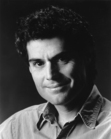Michael Shapiro's Blog, page 10
March 23, 2014
Art collector Jack Leissring: Eyes need to see this stuff
One thing I love about my job is that sometimes I have no idea where my day will lead. In early 2014 an editor emailed me on a chilly morning and that afternoon I was surrounded by the spirit-lifting art-filled warehouse of collector Jack Leissring. Here’s my story for Sonoma magazine. I only had a day and a half to write it, but sometimes I feel I work best when I work quickly. Click here to read story on Sonoma magazine site and see the photos by John Burgess: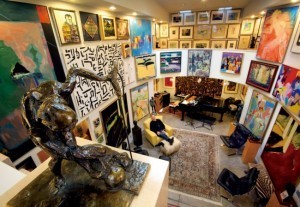
Sonoma magazine, March-April 2014
By Michael Shapiro
Just north of Railroad Square in Santa Rosa at Eighth and Davis streets is an elementary school on one corner and a chiropractor’s office on another. Across the street, adjacent to the humming freeway, is a nondescript sand-colored building, a converted warehouse whose outer appearance offers no hint about what lies hidden inside.
Jack Leissring, an artist and the former owner of the McDonald Mansion in Santa Rosa, has converted the warehouse into a luminous gallery for housing his wide-ranging, museum-quality collection. It’s a high-ceilinged, two-story space with a startling variety of paintings, drawings and photographs covering every wall, yet somehow it doesn’t feel cluttered.
“Almost every extra penny I have I spend on art, the other pennies I spent on women,” he says, pauses, then adds: “I still have the art.”
Throughout the space are tables with sculptures and busts, many made by artists who have become his friends. Most pieces are by creators who work under the radar, not those celebrated by museums and top galleries.
“Every piece I’ve ever purchased is because of an emotional response,” Leissring says, tapping a fist to his heart. “I have some big names, but that’s immaterial to me. This tendency we have to adulate some and ignore others is a tragic flaw.”
When a guest asks for a tour to “make sense of the collection,” Leissring shoots back: “That’s impossible – there’s no sense to it. This is the complete manifestation of my madness, and I can’t hide it.” On a more serious note, he adds: “There’s a lot of love here; I’m emotionally involved with probably every piece.”
He calls the warehouse the “emergency landing field” for his art, “in case I lose my house.” He lives next door to the McDonald mansion in its former carriage house surrounded by his own sculptures and other artwork he created.
Leissring, 78, bought the McDonald Mansion in the mid-1970s and sold it in 2005, which he said was a relief. “It was too expensive – I was doing it for the city,” he said. The historic, 19th-century home burned in the late ’70s. Leissring, who’s also a designer, restored it, saying it was “the best toy a boy could ever have.”
He started collecting art when he was a 12-year-old living in Milwaukee, when the only collections his peers were interested in were boxes of baseball cards. A year later he commissioned a painting for the first time.
His fascination with art deepened when he studied the work and writing of English sculptor, painter and author Michael Ayrton. Leissring calls Ayrton “the most intelligent, loquacious, talented polymath I’ve ever encountered, and I’ve been drawn along a pathway largely due to his influence.”
Winding through the warehouse are rows and rows of shelves containing thousands of art books. They’re organized alphabetically by subject – a random glance takes in large-format tomes about Kahlo, Kandinsky, Klee, Magritte and Miró.
Walking through the building, which Leissring completely remodeled and designed about eight years ago, feels like traversing a maze. The room dividers and shelves are made of bamboo flooring slats; square skylights large and small evoke a painting by Mondrian.
Etchings are displayed so they can be seen up close. But Leissring says only 2 to 3 percent of the 6,000 to 7,000 items in his collection is visible. Thousands of drawings are housed in wide drawers in the warehouse, which Leissring will gladly open upon request.
Though his art is lovingly displayed, Leissring’s warehouse is not a museum – it’s not open to the public – and it’s not a gallery. But every couple of months he welcomes visitors for an afternoon viewing because he believes “eyes need to see this stuff.”
Some visitors ask him to put up stickers describing the artworks, “but I say no,” Leissring says. “That would miss the point of it – either you’re moved by the image or you aren’t.”
Among his most treasured works are paintings and etchings by French cubist Jacques Villon, but Leissring says he’s considering selling his entire collection of Villon’s work, 358 pieces, which he believes is the largest in the world. “I’d love to sell it all because I think it belongs together.” He believes the Villon collection is worth $1.2 million.
The retired physician, who worked for three decades at Santa Rosa Memorial Hospital as laboratory director, reiterates that he doesn’t buy art to deal it.
“I’ve never bought anything for re-sale. … It puts art in the position of being commoditized. But I have two pieces of real estate, both with mortgages,” which can’t be covered by his Social Security check.
As the impromptu tour continues and mid-century jazz pours through small speakers in every room, Leissring describes a table of heads by the sculptor Jerrold Ballaine. He shows a visitor his second-floor desk, which overlooks his collection like the captain’s wheelhouse on a ship.
A mezzotint (a print created with gradations of black ink pressed into paper) by Leissring’s grandfather, John Cother Webb, is so precise and realistic the quality is almost photographic. Near that classic work is a more modern piece, a luridly colored painting called “Wild Dog” by Mexican artist Rafino Tamayo.
“They don’t have to be of a type to hang together,” Leissring says. “They just have to be good.”
Today, Leissring spends most of his days ensconced in his collection. A genuine Renaissance man, he arrives at the warehouse early in the morning, draws for an hour or more, then plays piano.
He has published dozens of books about artists he admires through his J.C. Leissring Fine Arts Press. When asked where they’re sold, Leissring exclaims: “Nobody buys them!” then concedes some can be purchased online as print-on-demand.
The warehouse is equipped with a kitchen and washer/dryer, making it move-in ready if Leissring needs to – or chooses to – give up the McDonald carriage house.
Asked if he’s been approached by museums or galleries about his collection, Leissring laughs and says: “Nobody knows about me. I’m not waving my flag. This is just something I had to do, and I did it.”
–
To get on the list of people that Leissring invites to see his collection, email him at jclfa@jclfa.com. To learn more about his collection, see jclfa.com or jclfineart.com.
–
Michael Shapiro is author of “A Sense of Place” and an entertainment writer for The Press Democrat. Contact him at michael.shapiro@pressdemocrat.com.
March 7, 2014
Connie Hale, Michael Shapiro offer workshop on “A Sense of Place” in Petaluma, Thursday, March 20, 7pm
The key to making a travel story – or just about any kind of story – compelling is a convincing sense of place. Readers want to know where they are, and this can be conveyed with everything from distinctive dialogue to landscape portrayals. Instilling a sense of place into one’s writing is essential, and a skill that takes time to hone.
Authors Michael Shapiro and Connie Hale will show you how to do this well by sharing examples from their own work as well as from the work of masters ranging from Mark Twain to Isabel Allende to Jonathan Raban. The workshop will be the March edition of the Petaluma Writers Forum, all are welcome: Thursday, March 20, 7pm to 9pm, Petaluma Community Center, 320 No. McDowell Blvd., Petaluma, $10.
Hale and Shapiro will discuss some of their favorite places and how the bring them to life on the page. We’ll also be selling our books, so if you’d like a signed copy of Shapiro’s “A Sense of Place” or Hale’s “Vex, Hex, Smash, Smooch” come join us for what promises to be a night of stimulating conversation.
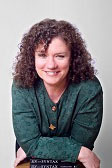 Constance Hale is the author of Vex, Hex, Smash, Smooch: Let Verbs Power Your Prose, as well as Sin and Syntax and Wired Style. She curates Sin and Syntax, an online salon “for those who love wicked good prose.” She has been a staff editor at the Oakland Tribune, the San Francisco Examiner, Wired, and Health magazines, and her journalism has appeared in The Atlantic, Smithsonian, The Los Angeles Times, Honolulu, and many other national publications. Her eight-part series on writing a sentence is at The New York Times’ Opinionator. Hale also edits books and is a founder of The Prose Doctor.
Constance Hale is the author of Vex, Hex, Smash, Smooch: Let Verbs Power Your Prose, as well as Sin and Syntax and Wired Style. She curates Sin and Syntax, an online salon “for those who love wicked good prose.” She has been a staff editor at the Oakland Tribune, the San Francisco Examiner, Wired, and Health magazines, and her journalism has appeared in The Atlantic, Smithsonian, The Los Angeles Times, Honolulu, and many other national publications. Her eight-part series on writing a sentence is at The New York Times’ Opinionator. Hale also edits books and is a founder of The Prose Doctor.
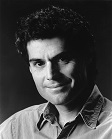 Michael Shapiro’s article on Jan Morris’s Wales was a cover story for National Geographic Traveler. He also writes for American Way, Mariner, Islands, and The Sun – and contributes to the travel sections of the Washington Post, Los Angeles Times and San Francisco Chronicle. Shapiro is author of A Sense of Place: Great Travel Writers Talk About Their Craft, Lives, and Inspiration and wrote the text for the pictorial book, Guatemala: A Journey Through the Land of the Maya. A native of New York, he’s lived in Sonoma County for almost 20 years, and in Petaluma since 2009.
Michael Shapiro’s article on Jan Morris’s Wales was a cover story for National Geographic Traveler. He also writes for American Way, Mariner, Islands, and The Sun – and contributes to the travel sections of the Washington Post, Los Angeles Times and San Francisco Chronicle. Shapiro is author of A Sense of Place: Great Travel Writers Talk About Their Craft, Lives, and Inspiration and wrote the text for the pictorial book, Guatemala: A Journey Through the Land of the Maya. A native of New York, he’s lived in Sonoma County for almost 20 years, and in Petaluma since 2009.
Join us: Thursday, March 20, 7pm to 9pm, Petaluma Community Center, 320 No. McDowell Blvd., Petaluma, $10.
January 28, 2014
Pete Seeger: 3 stories you’ve never heard
By Michael Shapiro
Was sad to hear about the death of folk legend Pete Seeger today – here are three stories you won’t read in his obits.
1. Decades ago, Warren Hellman, then a NY investment banker (he was head of Lehman Bros.), asked Seeger if he would teach him how to play the banjo. Seeger said he has no use for bankers or Hellman’s money. (Hellman told me this when I interviewed him in 2009.)
Seeger was a man of the people, but too bad he couldn’t recognize that sometimes those in the 1% are good people too. Hellman founded and paid for the Hardly Strictly Bluegrass festival in SF, bringing free music to millions of people over the past 13 years.
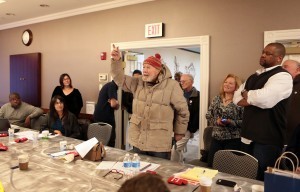
Legendary folk singer Pete Seeger stopped by the Great Lakes-Midwest Joint Council Meeting in Buffalo on Nov. 9. Photo by David Carson.
And Hellman, who became an accomplished banjo player without Seeger’s help, left a fund to continue paying for the fest after his death, which came way too soon. Maybe Warren and Pete will find each other in the afterlife and do a little pickin’ together.
2. Just two months ago, Seeger appeared in support of the Buffalo newspaper guild to encourage the union to fight for its rights. From the guild’s newsletter story on Seeger:
The 94-year-old walked into the conference room at the Hampton Inn, stepped onto a chair and proceeded to sing, a cappella, the satirical “Newspapermen Meet Such Interesting People,” and later shared with the group his early aspirations toward a career in journalism.
When local folk singer Phil Knoerzer, who performed at the special Guild program, shared with Seeger that he had earlier in the day sang a song by folk icon Woody Guthrie called “Union Maid,” Seeger responded: “I was with Woody when he wrote that song.” We looked it up and, indeed, it occurred in June 1940 – a mere 73 years ago.
3. From the great oral historian Studs Terkel, whom I interviewed for The Sun magazine a couple of years before he died:
I loved music as a kid. I never played an instrument, and I can’t carry a tune, but I’d hear that music, the music played by black bands — the patrons were all white, but the bands were black. And then folk music came about during the Great Depression. When I was an actor, I ran into this group called the Almanac Singers. They sang at labor rallies and traveled in a jalopy around the country. And that group had Woody Guthrie in it.
One day they came to Chicago Repertory. We were doing a play about a strike or something. I’d just gotten married, and my wife and I had a two-and-a-half-room place with a pull-down Murphy bed. I sent these guys back to my place about twelve o’clock at night to sleep. I write a note to my wife to send along with them. It says, “These are good guys. Put them up for the night.”
Well, she’s asleep, and the bell rings about 12:30 at night, and she goes to the door. There are four guys standing there: A little, freckle-faced guy; that’s Woody. And a kid with a big, bobbing Adam’s apple; that was Pete Seeger. And a huge man from Arkansas named Lee Hayes. And one other. They were there for two weeks, sleeping on the floor together. And one night I woke up, and Woody was asleep, and in the wastebasket were about twenty crumpled pages, single-spaced, and, so help me, it was fantastic writing. And I threw it away, wouldn’t you know.
Click here for excerpt from my Sun interview with Terkel.
–
RIP, Pete.
December 11, 2013
SF Chronicle: Holding on to a travel companion who wouldn’t let go
Exactly 10 years ago today my mother, brother and I sat with my father as he drew his last breath. He’d been battling pancreatic cancer for eight months; I’d been on assignment in England, interviewing travel writers for my book, A Sense of Place when he took a turn for the worse. I got home the day before he died – he wanted to watch a Warriors game – Dunleavy missed a shot at the buzzer that would have won it. Click here for the essay I wrote for the SF Chronicle about rushing home to see him and the memories of how he held on to me at my time of greatest risk:
http://www.sfgate.com/travel/departur...
By Michael Shapiro
As a planeload of people stared at their tiny seat-back screens, I raised the cover of the oval window and witnessed my second dawn of the day. The orange-pink light illuminated the crystalline snow below that blanketed Baffin Island like diamond dust. This second dawn, which kindled my wavering hopes, brightened the horizon just a couple of hours after my first sunset of the day, when our 747 nosed above the Arctic Circle and into December’s round- the-clock darkness over central Greenland.

My father, Lawrence Shapiro, left, with his father, Harry.
The brilliance of the second sunrise contrasted sharply with the day’s first dawn. My cell phone rang before 7 a.m. with a message from my wife that my father, who was battling cancer, was slipping away. The iron skies over London barely lightened as I packed; a friend drove me to the airport through thick, sepulchral fog. It was a typical December day in London, one in which the sun climbs meekly into the southern sky for a few hours before beating a hasty retreat from the bone-chilling cold and bluster.
Because my wife told me every minute could count, I intended to carry on my small backpack, my only bag. But it exceeded Virgin Atlantic’s weight limit, and despite the urgency of my situation, the gate agent refused to let me carry it on. After getting seated, my frustrations mounted: We’d be delayed 40 minutes due to the fog, the captain said. Forty minutes later he said the delay could be two hours because so many planes were stacked up waiting for takeoff.
I knew that if we were delayed too long our pilots would be disqualified because they can only work so many hours. With an 11-hour flight to San Francisco, we had to go soon or we would lose this crew. If the flight canceled, I probably wouldn’t be able to leave London until the following day.
The captain said we’d been scheduled to take off at 1 p.m., exactly two hours late. We crawled up the runway, and with every inch of progress I breathed a bit more easily. Two minutes before 1 p.m., I heard the engines rev. After rolling over the length of several football fields, we left the ground.
As the anxiety of the delay ebbed, I recalled a trip my family — my parents, grandparents, brother and I — took to Venezuela when I was 10 to visit an old friend of my mother’s, named Chata, in Caracas. After a few days in Caracas, Chata and her clan took us to their vacation house in a remote jungle. Never had I seen pigs sauntering down a dusty main street, never had I slept in a hammock draped with a mosquito net, and never had I seen an emerald snake slither silently into the shrubbery.
Chata told us we’d be going to one of the country’s most beautiful beaches, but first we’d have to navigate through a horseshoe of sea caves. When we arrived at the caves’ mouth, about 2 feet high and 10 feet wide, the adults huddled and seemed agitated. Usually the water is about knee-high inside the caves, Chata told us, but the tides were high and the water would be above everyone’s waist. We had enough young men in our group of 20-some people to form a human chain and pass the kids through the deepest water. My grandmother, younger brother and mother stayed behind.
When we got inside, I realized it wasn’t just that the water was deep — the tides could yank out to sea anyone who lost their grip. The thunderous concussions of water against stone reverberated inside the caves. As my father held my hand, we walked into deepening waters.
We grasped the caves’ walls and stepped tenuously toward the chain of young men. My father reluctantly released his grip. In seconds I was passed from body to body, then steadied myself. Through the knee-high horizontal exit, a sliver of shimmering beach opened into a broad crescent of fine, fawn- colored sand as the sea stretched into shades of turquoise, azure and lapis. No one else was there. It was a postcard made real.
Soon my father emerged and we lounged in the sand, talking about whether Walt Frazier and the Knicks would win another championship — they would, three months hence — and whether the Yankees would ever get good again. The sun warmed us. Despite the moderate surf, we plunged into the tropical waters, my father warning me to stay close to him. I floated on my back, stared at the cottony clouds and let the waves ride me up and down, up and down.
“Michael!” my father shouted, shattering my reverie. Behind me, I saw him and the biggest wave I’d ever witnessed, both zooming toward me. My father grabbed my hand — we were too far out to beat the wave to shore. After a few terrifying seconds, the wave began to curl over us in slow motion and enveloped us with unrelenting force. The surf spun us around like driftwood; my father’s grip tightened. As the wave slammed us into the scabrous ocean floor, he held on. And when the undertow began to suck us out to sea, his grip remained strong as he swam us — with his one free arm — toward the shore.
As I reflected on that 30-year-old scene I could again feel my father holding on, across the dwindling miles. And I knew that despite the pain the cancer was inflicting on his body, his spirit wouldn’t let go until we embraced one last time.
–
December 2, 2013
American Way: Ultimate Tequila Tour
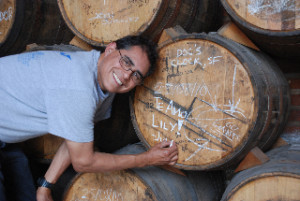
Julio Bermejo signs a barrel at Arette distillery in Tequila in August, 2013. All photos by Michael Shapiro
In 2004 in Las Vegas I went to a tequila tasting and met Julio Bermejo. A world of spirit opened up to me – not only did I learn how good tequila can be, I was captivated by Julio’s effusive energy and got to know him at Tommy’s Mexican Restaurant in SF. In August, Julio and I traveled to Jalisco after I got an assignment to write a feature for American Way, the magazine of American Airlines.
Here’s a link to the story, in the Dec, 1 issue of American Way, but I recommend reading my uncut text below.
http://hub.aa.com/en/aw/tequila-disti...
Read to the end for the sidebar on Julio.
–
By Michael Shapiro
“Follow me into the cave,” says Guillermo Sauza, the fifth generation in his family to make Mexico’s sacred spirit. A wide, heavy wooden door creaks open and we go from bright Jalisco sunshine into the near pitch-blackness of a serpentine passageway.
Slowly my eyes adjust to the dim light as we walk gingerly underground. I leap back when I see a skull-topped slumping effigy.
“Watch out for the Cuervo drinker,” Guillermo says. “He’s dead.”
Though the Sauza family sold their brand decades ago – it’s now owned by Jim Beam – the generations-old rivalry between Mexico’s two leading tequila families remains alive.
In 2002, Guillermo got a distillery going on this patch of land in the town of Tequila, about an hour’s drive west of Guadalajara. He now makes an ultra-premium tequila, called Fortaleza, the way his tatarabuelo (great-great-grandfather) did, by crushing agave with a tahona – a wheel-like stone that weighs more than a ton – and distilling it in copper pot stills.
The Fortaleza distillery doesn’t have scheduled tours, but it’s one of many tequila makers in the eminently walkable pueblo of Tequila that welcomes visitors by appointment.
Over the course of two whirlwind days in Tequila and one in the highlands town of Arandas, I visit eight distilleries with Julio Bermejo, beverage manager of Tommy’s Mexican Restaurant in San Francisco and a longtime evangelist for fine tequila (see related story).
At Fortaleza, we – Julio, his wife Lily, Guillermo, his golden retriever Sandy, and I – emerge from the dimly lighted corridor into the caves’ largest “room” where bottles of tequila sit atop a pedestal of golden light.
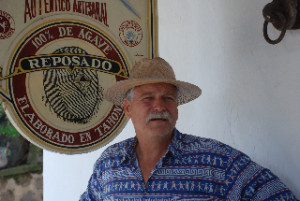
Guillermo Sauza at his Fortaleza distillery in the town of Tequila in August, 2013.
Guillermo, wearing a Hawaiian shirt and wide-brimmed straw hat, tells us he didn’t plan to base his business on tequila made from stone-crushed agave. But he made a batch and everyone said, “Wow, this is so good,” so the company decided to use the tahona.
The process starts with harvesting the football-shaped agave heads – the root of the plant that can be 2 feet long and weigh 50 to 200 pounds. The spiky leaves are hacked off with a long-handled blade called a coa. Then the heads, called piñas because they look like enormous pineapples, are roasted under pressure in brick ovens.
As the agave cooks, steam fills the air. The smell evokes Thanksgiving: molasses, brown sugar and sweet potatoes with a hint of pumpkin pie. The agave fibers are removed, then the liquid, called mosto, is fermented pot-bellied stills. “It’s like going back in time,” says Julio.
Tilting his glass, Guillermo adds: “When you see me at a party with a glass three-quarters full, it’s not Chardonnay.”
We sample three varieties – the blanco (unaged) is clean and crisp, the reposado has a rich caramel flavor, and the ultra-smooth añejo lingers with a full-bodied aftertaste.
Now that he’s achieved success with Fortaleza, I ask if Guillermo if he regrets that his family sold Sauza. “My heart is here in Mexico – I thought I’d be running Sauza,” says Guillermo as he sips.
“Unfortunately my father sold (Sauza) in 1976 – I was 20 … but I’m fortunate to walk in the footsteps of my ancestors,” he says. “It’s a battle: agave shortages, broken bottles, but it’s a labor of love. There’s a lot of competition in this business. But I thank God every day that I get to do what I’m doing.”
* * *
Across the street is the boutique distillery Arette. Eduardo Orendain, the earnest 21-year-old son of the owner and the fifth generation to work in his family’s business, grew up with tequila.
We talk in the concrete patio where the piñas are unloaded and cut open, surrounded by autoclaves (modern pressurized ovens) where they’re roasted, and greased black gears that power the fiber-removing shredders.
“I love tequila,” Eduardo says. “Since I was little I rode horseback in the agave fields, but my family put me to work – I had to clean the bottles.”
Julio notes that Arette’s tequila embodies the region’s terroir: “pungent, herbaceous, green notes with an earthy vegetal flavor,” he says. “Arette is all of that with a nice body and a strong finish.”
We go Arette’s barrel room and absorb the warm welcoming scent of tequila dancing with oak.
“It smells so good in here, but you know who’s reaping the benefit?” Julio says. “The angels!” Liquor that evaporates during aging is called “the angels’ share” and Julio says 8 to 10 percent of tequila is lost during each year – compared to about 2 percent for cognac. “I’m not sure how much the angels like cognac,” he says, “but I’m sure they love tequila!”
After visiting these boutique distilleries, Julio and I go to see how the big boys work. At the expansive Cuervo compound, with lush gardens, fountains and modern art on the grounds, Sonia Espinola tells us that “it’s don Juan’s vision to make Tequila a destination.”
Cuervo is now run by Don Juan’s son, Juan-Domingo Beckmann, the sixth-generation leader of the company. “He sees Tequila as a place with a legend, a story, everything,” Sonia says. And he’s not the only one. Mexico deemed the town a Pueblo Magico in 2003 and Tequila became a World Heritage Site in 2006.
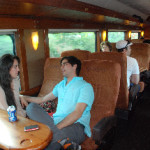 Many visitors arrive on the Jose Cuervo Express, a train that leaves Guadalajara weekend mornings at 11 a.m. It features views of the agave-spiked landscape and the looming Volcan de Tequila, and all the tequila you care to drink.
Many visitors arrive on the Jose Cuervo Express, a train that leaves Guadalajara weekend mornings at 11 a.m. It features views of the agave-spiked landscape and the looming Volcan de Tequila, and all the tequila you care to drink.
Passengers have about four hours to tour the distillery and have lunch, then most depart at 5:30 to return to Guadalajara. But with programs such as the Ruta del Tequila, a route of sights in the town and beyond, Cuervo hopes to encourage visitors to stay a night or two.
And why not? With so much to do – tequila tasting, visiting storied bars, horseback riding, and walking the time-worn cobblestone streets to hear impromptu guitar performances – it’s worth lingering.
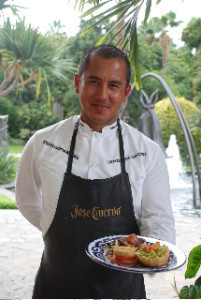 We start lunch at Cuervo with delicious guacamole and wash it down with a margarita blended with roasted agave (which gives the drink a textured mouthfeel), stirred with an agave stalk. Bartender Hugo Sanchez gyrates from side to side as he shakes the drink. “If he doesn’t dance,” Sonia says, “it doesn’t work.”
We start lunch at Cuervo with delicious guacamole and wash it down with a margarita blended with roasted agave (which gives the drink a textured mouthfeel), stirred with an agave stalk. Bartender Hugo Sanchez gyrates from side to side as he shakes the drink. “If he doesn’t dance,” Sonia says, “it doesn’t work.”
The VIP tour culminates with the filling of our own bottle of Cuervo’s finest tequila, its Reserva de la Familia. Sonia hands me a bottle, and I fill it from an old oak barrel. I pop in the cork, invert the bottle and dip it in molten red sealing wax, then stamp it with Cuervo’s insignia.
On the way out, I spot Hugo the bartender. He asks if we want to see something special and leads us down to a cellar with huge, dusty, antique, pear-shaped bottles. In an oak barrel is Cuervo’s Reserva.
He pulls a big cork out of the top, dips in a long narrow ladle called a ladron (thief), and pours me a glass of amber perfection. We’re late for the train back to Guadalajara, but I can’t bear to leave before finishing this work of art in a glass.
* * *
The next morning we start at another tequila giant, Sauza. The three-hour tour includes a visit to the fields, about a 10-minute drive in the Sauza trolley, where you can wield a coa and cut the succulent, thick, blue-green spikes from agave heads. It’s hard work – I can’t imagine how the jimadores cut 200 heads a day.
For the tour of Sauza’s compound, called La Perseverancia, we don hard hats and start with a taste of Casa Sauza X.A., a limited edition five-year-old tequila. Until this moment, I’d thought that Sauza just made cheap tequila. When I taste the X.A., I realize Sauza can make tequila that’s resplendent, an amber symphony of jasmine, hibiscus and almond notes with a coda of chocolate.
It’s still Monday morning. “That’s the way we start the week here at La Perseverancia!” says our tour guide Karina Sanchez.
Covering one wall is a huge mural evoking the history of tequila, starting with lightning striking an agave plant and ending with an image of Venus-like maidens who represent the four states of drinking tequila: happiness, sadness, lust and lack of inhibition.
At Sauza’s bar, mixologist Charly Garcia creates a cocktail with strawberry, kiwi and pomegranate liqueur. As we sip, Victor Martinez of Sauza’s Heritage Center tells me that Sauza has launched a food-pairing initiative. “Here in Mexico we mix culture, food and alcohol, even the wife,” he says. I vow to return for lunch soon.
Driving out of Tequila we pass endless fields of azure agave plants stretching for the heavens as fingers of fog reach down the slopes of the looming Volcan de Tequila.
“Grape fields are all over the world, but agave grows only here,” Julio remarks. “It gives you a sense of place. When you see agave fields, you know where you are – it reminds you everything comes from the land.”
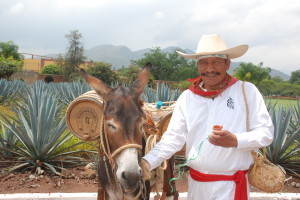
Tequila barrels on a burro at Herradura hacienda.
We drive 15 minutes to Amatitán and the storied Herradura hacienda, a family distillery for seven generations until sold to spirits conglomerate Brown-Forman in 2007. Herradura means horseshoe and hitching posts remain in front of the hacienda’s gates.
Our guide, Angel del Gado, tells us fine tequila is made by cutting the spikes completely down to the agave head and by using very ripe agave for high sugar content.
As we tour the hacienda, we’re joined by Pedro, clad in traditional white shirt and pants with a red sash, and a barrel-laden burro called Cuko. One cask has Herradura’s El Jimador brand, which we sip from a handmade clay cup.
Nearby, in the hills above Tequila, is Casa Noble, which has made a name for itself with triple-distilled premium tequila that’s organic and kosher. Aged in French white oak barrels, Casa Noble is made at the Cofradia compound, which includes lavishly decorated hotel rooms and a restaurant called La Taberna serving everything from fishbowl drinks to locally-sourced lunches.
[image error]
David Yan in Casa Noble’s “time machine” in August, 2013.
Casa Noble uses atmospheric fermentation, which means its tanks are open to wild yeast in the air. The best way to evaluate tequila is straight from the tank, says our guide, David Yan. “You can’t imagine what tequila really tastes like until you’ve tasted it straight from the still.”
Guitarist Carlos Santana, who was born about 50 miles from here, recently became a part owner of Casa Noble and his image now adorns a line of its bottles, with profits going to Santana’s Milagro Foundation.
As we sit down to taste, David notes that taking a shot isn’t the way to enjoy tequila. “It’s like drinking boiling coffee and getting scalded,” he says. The right way is to sip it, slowly. “It’s not one quick bang – how about the cuddling and kissing – that’s what makes it more enjoyable.”
David shows us Casa Noble’s “time machine,” a collection of hand-labeled bottles from various barrels. “This is seven years of history,” David says. Making fine tequila “doesn’t happen by chance, it happens by studying your past.” Gesturing to the wall of bottles, he adds: “This is like a family album of how a barrel looked and smelled and tasted.”
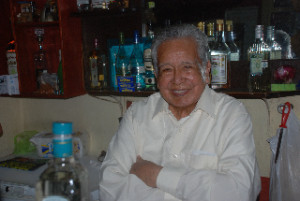
Don Javier, on the eve of his 90th birthday, has been pouring tequila in the town of Tequila since he was a teenager.
Returning to town, we stop in to see don Javier Delgado, an 89-year-old bartender, at La Capilla, which means “the chapel.” That seems fitting as the room honors Tequila’s spirit, with bottles from local distilleries and soccer trophies adorning the walls.
Wearing a white, button-down shirt, silver-haired don Javier makes his classic drink, the batanga (blanco tequila, Mexican Coke, lime and a stir with his favorite knife, the one he uses to slice chilis for hot sauce). He tells us he’s been pouring tequila for 76 years.
I ask what he’s most proud of in his life. “Pride, no,” he says in Spanish. “What makes me most grateful is everyone who has come and shared hospitality with me. I don’t want you to feel like you are in our house – I want you to feel like you are in your house.”
* * *
The town of Tequila isn’t the only region where Mexico’s national spirit is distilled. Some of the best producers are in the highlands (elevation over 6,000 feet), two hours drive east of Guadalajara, so we travel to Arandas to visit Centinela and Tapatio.
Though Centinela makes more than a million cases a year, the distillery still uses traditional stone ovens to roast agave. As we tour, Julio notices that Centinela’s Classico Blanco, widely available in Mexico for under $15 a bottle, is being fermented with bagazo (agave fibers).
“It doesn’t make sense to make a cheaper tequila with this expensive process, but we do it for the taste,” says our tour guide Jesenia Aracely Davida Jimenez, noting that Centinela means “sentinel.” The company’s chemist Ramiro Morales Galindo adds: “Fermenting with fiber is not new, but few do it and we’re bringing it back.”
After lunch with a side of banda music at Arandas’ best restaurant, Carnitas Jaime’s, we visit Tequila Tapatio. Carlos Camarena, Tapatio’s director, welcomes us and shows us the company’s new bottling line, but he’s most proud of adhering to generations of tradition. A tahona (grinding stone) is used to mash the agave for Tapatio’s premium brand, El Tesoro de Don Felipe.
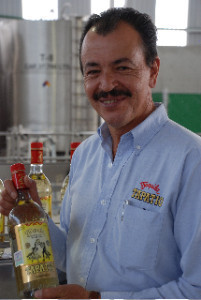 The process is “old and inefficient,” Carlos says, “but this is the way my father and grandfather did it.”
The process is “old and inefficient,” Carlos says, “but this is the way my father and grandfather did it.”
Also touring that day is Tom Wright, a Los Angeles-based actor who appeared in several Seinfeld episodes in the mid-’90s. We sip divine tequila from the cut tips of bull’s horns, which is how Mexican cowboys once drank it and is the origin of the modern tequila glass.
“When we used to drink tequila,” Tom says, “we asked, ‘where’s the worm?’ It’s amazing how far we’ve come in 25 years.”
We go down to Tapatio’s fragrant barrel room, with rows of casks 20 feet high. Carlos jokes that it would be the ideal bomb shelter: “In case of nuclear war we have our bunker ready, and plenty of tequila. Just bring the appetizers!”
Seagram’s approached the Camarena family and “offered way more than the company was worth,” Carlos says in English, “but you know what, we didn’t accept. One reason is that we don’t want our kids to have plenty of money and nothing to do – it would destroy them.”
Perhaps the most important reason is Carlos’ deep appreciation for the company’s legacy. “To build a reputation takes lots of years – we have 76 years of tradition of making a good quality product. That could be destroyed in a minute,” he says. “We have a decent living. That’s all we need.”
–
Michael Shapiro, author of A Sense of Place, last wrote for American Way about the narrow-gauge trains of Wales: www.michaelshapiro.net
–
SIDEBAR:
THE AMBASSADOR OF TEQUILA
Growing up the son of Mexican immigrants in San Francisco, Julio Bermejo worked at his family’s Tommy’s Mexican Restaurant. “I cut tomatoes, shredded lettuce, grated millions of pounds of cheese,” he said. Restaurant work is “the last form of legalized slavery. You better be in love with it if you want to succeed.”
As a young man Julio was embarrassed by the work – until he discovered pure agave tequila. Tending bar at Tommy’s, he began making margaritas with Herradura 100-percent-agave tequila.
“My father went ballistic,” Julio said. Compared to cheap mixed tequilas, “it was four times as expensive! But people could taste the difference.”
In the late ’80s, Julio tried Patron and El Tesoro. “That blew me away,” he said, and propelled him on a pilgrimage to Jalisco, the Mexican state where most tequila comes from.
“I knew Patron and El Tesoro were different but didn’t know why or how,” he said. El Tesoro’s don Felipe Camarena and his son Carlos welcomed Julio with open arms and showed him how fine tequila is made. Julio didn’t just fall in love with tequila on that trip; he became smitten with Carlos’ sister, Liliana.
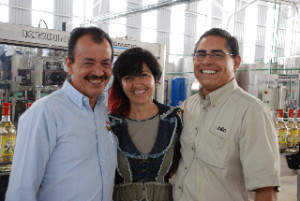
Lily and Julio Bermejo with Lily’s brother, Carlos Camarena, director of Tapatio distillery in Arandas.
“It’s took me 13 years to get a date with Lily,” Julio said. Carlos shot back: “That’s because every time you visited you brought a girlfriend!” Julio and Lily were married in 2006. “I lost every battle,” Julio said, “but I won the war.”
Returning to San Francisco, Julio founded the Blue Agave Club at Tommy’s to encourage customers to try various 100-percent-agave tequilas. The first incentive: taste a number of different tequilas and get a T-shirt; that evolved to a framed diploma.
But people wanted more. So Julio launched a card for graduates. Fill it and score 80 percent or better on a notoriously difficult test about tequila, and you can become a “Demigod” and travel to Mexico on one of Julio’s tasting tours. The club now has more than 8,000 members, not all active, he says.
It’s not just marketing skill that makes Tommy’s a destination for tequila lovers – it’s Julio and his family’s warmth and graciousness. Now beverage manager at Tommy’s, Julio welcomes most returning customers by name, asks about their families and seems to know what kind of tequila they like – and what other tequilas they should try.
Because Julio has shared his passion for fine tequila with so many people and has become so knowledgable about the spirit, the Mexican tequila promotion authority CNIT gave him the title, Ambassador of Tequila to the United States.
Director Mel Lawrence was so taken with Julio and his love for tequila that he’s making a documentary about him. It’s called, of course, The Ambassador of Tequila.
What’s next for Julio and Lily? They’re building their own small distillery in Jesus Maria near Arandas and hope to open and welcome visitors next year.
Tommy’s Mexican Restaurant, 5929 Geary Blvd., San Francisco, Calif., (415) 387-4747, www.tommystequila.com.
–
A TEQUILA PRIMER
What’s tequila?
A spirit made from blue agave harvested in one of five Mexican states. Most tequila comes from Jalisco, the state that has the namesake town of Tequila.
What are the primary types of tequila?
Blanco is clear, straight from the still and unaged. Reposado is aged in oak from two months to a year, and añejo is aged one to three years. A relatively recent category is extra añejo, which is aged for more than three years.
Is all tequila made just from agave?
No, just the finer ones. The spirit must have at least 51 percent agave to be called tequila, but premium tequilas are 100 percent blue agave.
Does tequila have a worm in the bottle?
No, that’s mezcal.
–
IF YOU GO
Regular tours are held at Sauza and Cuervo. Smaller producers will show you around by appointment – it’s best to book a week or more in advance.
Mundo Cuervo
Tours seven days a week, 10am-5pm, until 6pm on Saturday
Jose Cuervo No. 73, Col Centro
Tequila, Jalisco, Mexico
tours@cuervo.com.mx
en.mundocuervo.com
Jose Cuervo Express tequila train:
en.josecuervoexpress.com
Casa Sauza
Tours M-F, 9:30am to 4pm, Saturday until 12:30pm
Francisco Javier Sauza #80 Col. Centro
Tequila Jalisco
tourstequilasauza@beamglobal.com
www.casasauza.com/en-US/distillery-tour
866.510.2250 (US toll-free)
Herradura and its Tequila Express train
The train runs on weekends: www.herradura.com
To visit other times, fill out the form at:
www.herradura.com/contact-us.aspx
TOURS BY APPOINTMENT
Fortaleza
Contact the Sauza family’s Museo Los Abuelos
Vicente Albino Rojas, No. 22
On the central plaza in Tequila, Jalisco
011-52 374-742-0247
Open daily: 10am – 4pm
Info@LosAbuelos.com
museolosabuelos.com
(Note: Fortaleza asks not to list its address because they don’t want visitors appearing on their doorstep.)
Arette
Silverio Nuñez #100, Tequila, Jalisco
Advance notice preferred, visits welcomed between 8am and 4pm
Phone: 011-52 33-3615-0192
Email: eog@tequilaarette.com
Casa Noble
Av. Vallarta 6503 Local C-2, Int. 4 Plaza Concentro,
Zapopan, Jalisco
011-52 33-1404-4014
dyan@casanoble.com
Tapatio
Tours Tuesday, Thursday & Saturday at 10am or noon.
011-52 348-783-1666
tequilatapatio@hotmail.com
(Directions and address provided when tour booked.)
Centinela
Tours by appointment
Rancho el Centinela
Arandas, Jalisco
011-52 348-783-1192
ccenteno@hotelcentinelagrand.com
HOTEL IN GUADALAJARA
Quinta Real
Av México 2727, Vallarta Norte,
Guadalajara, Jalisco
011-52 33-3669-0600
www.quintareal.com/switchlang/en
HOTEL IN TEQUILA
Los Abolengos
Calle Mexico 138, Zona Centro CP46400
Tequila, Jalisco
011-52 374-742-4242
HOTELS IN ARANDAS
Hotel Centinela Grand
Obregon No.48, Arandas, Jalisco
011-52 348-783-1192
hotelcentinelagrand.com
Hotel Santa Barbara
Prolongación Fco. Medina Ascencio #553
Arandas, Jalisco
011-52 348 78-337-37
-end-
October 16, 2013
Gambling column: NBA title futures
Here’s my latest Gambling column from the San Francisco Chronicle, on odds to win the NBA title. As expected, Miami is the favorite, but Golden State has it’s best odds in more than a decade. Read it on sfgate.com using the link above or see the full text below:
Odds say NBA’s Warriors decent pick to win it all
By Michael Shapiro
It’s been “a long time” since the Golden State Warriors were predicted to win more than 50 games, says Nick Bogdanovich, director of trading for William Hill. But this year the over/under on the Warriors is 51.5 games, meaning that if you bet the over and the Warriors win 52 or more of their 82 regular-season games, you win.
 If they stay healthy and new addition Andre Iguodala plays to his potential, the Warriors have a legitimate – if not huge – chance to go all the way, Bogdanovich says. “They’re a year older, and with Iguodala, who knows how far they could go.”
If they stay healthy and new addition Andre Iguodala plays to his potential, the Warriors have a legitimate – if not huge – chance to go all the way, Bogdanovich says. “They’re a year older, and with Iguodala, who knows how far they could go.”
William Hill, a British gambling company, runs more than 100 sports books in Nevada and Delaware that list the Warriors at 10-1 to win the NBA title.
The favorite is the Miami Heat (11-5), but that doesn’t mean Miami is a lock. “They’re not unbeatable,” Bogdanovich said. “I don’t think you can just hand the trophy to the Heat. Lots of things have to go right for them to repeat.”
Other strong contenders include the Indiana Pacers at 8-1 and the Oklahoma City Thunder at 13-2. Bogdanovich says the Thunder could win it all if they stay healthy, but with guard Russell Westbrook’s recent knee surgery, “they’re not starting out on the right foot.”
A perennial contender that’s cost sports books a lot of money in recent years is the Los Angeles Lakers, but Bogdanovich doesn’t see them making the playoffs: “Father Time – and bad personnel decisions – caught up with them.” The Lakers are 35-1 to win the title. The other L.A. team, the Clippers, are 8-1 to win it all.
A word of advice: Futures bets should be made in small amounts for fun, as the house typically keeps about 25 percent of money wagered. If you’re serious about betting, stick with wagering on individual games, where the house take is about 5 percent.
Sports betting isn’t legal in California, but it is in Nevada; wagers can also be made online at sites based outside the United States.
One such site is Bovada.lv – its sports book manager, Kevin Bradley, noted the Warriors opened at 25-1 and have dropped to 16-1 (still better odds than Warriors futures at William Hill and elsewhere).
“We took a lot of money on the Warriors early on,” he said. But he still doesn’t consider the Warriors a top-tier team, among the likes of the Heat, Bulls and Thunder.
“Basketball isn’t often like hockey, where a sleeper team can get hot and win it all,” Bradley said. “Barring a miracle, teams like Sacramento (300-1) won’t make it.”
–
Michael Shapiro is a freelance writer and author of “A Sense of Place.” Email: 96hours@sfchronicle.com Twitter: @shapirowrites
October 15, 2013
Wash Post: Dylan Thomas’s Wales
I’ve long felt a kinship with Wales, perhaps because it’s where one of my favorite writers, Jan Morris, lives. Recently I had the chance to stay overnight and tour Dylan Thomas’s boyhood home in Swansea. Then I visited his other homes in Laugharne and New Quay. After the story ran in the Washington Post, I received a letter from a NY-based former embassy officer who helped Dylan clear customs on his last trip to America.
Below is the full uncut story, or click the link above for the slightly shorter version that ran in the Post — the letter is below:
In Search of Dylan Thomas:
Seeking the elusive poet whose words brought Wales to the world
“This is not a museum,” says Annie Haden, the vivacious Dylan Thomas enthusiast who has restored the Welsh poet’s childhood home in Swansea, an industrial city on Wales’ south coast. “I’m the oldest thing in this house!”
About 60 years old, Annie, who tells me to call her by her first name, is displaying some Welsh hyperbole – she’s not the oldest thing in this loving memorial of Wales’ best-loved English-language poet. There’s a typewriter from the 1920s, colorful drawings based on phrases from Thomas’ poetry, antique copper kettles, even oblong filament lightbulbs that looked like something fashioned by Thomas Edison.
 But she’s right – it’s not a museum. Annie, who has spent years refurbishing Thomas’s first home, is intent on making this a living breathing house, a place where the writer’s admirers can eat, drink, recite poetry, play music, and stay the night.
But she’s right – it’s not a museum. Annie, who has spent years refurbishing Thomas’s first home, is intent on making this a living breathing house, a place where the writer’s admirers can eat, drink, recite poetry, play music, and stay the night.
“Would you like a drink?” she asks me. “It is a Thomas house after all.”
The nation of Wales is gearing up to celebrate the centennial of Thomas’ 1914 birth so I thought I’d explore the coastal homes where he wrote and found solace, the beaches that made his spirit soar, and perhaps a favorite pub or bookstore. Like many of his countrymen, I appreciate Thomas’ work, though I can’t say I fully comprehend it all. I’m hoping that visiting places that shaped and inspired him will give me a deeper understanding of the artist and his words.
Thomas, who died before his 40th birthday, is often remembered as much for his excessive drinking and womanizing as for his art, but his poems, including “Do not go gentle into that good night” which he wrote for his dying father, have stood the test of time.
* * *
“And I fly over the trees and chimneys of my town, over the dockyards, skimming the masts and funnels … over the trees of the everlasting park … over the yellow seashore and the stone-chasing dogs and the old men and the singing sea. The memories of childhood have no order, and no end.” –Dylan Thomas, Reminiscences of Childhood
Located in the Uplands suburb of Swansea, Dylan Thomas’ birthplace is a handsome Edwardian two-story house on the steep part of Cwmdonkin Drive. Out front attached to the white stucco facade is a simple round plaque reading: “DYLAN THOMAS, A man of words, 1914-1953, was born in this house.”
I arrive on a rainy afternoon a few hours after touching down at London’s Heathrow; the brick-red tiles in the entryway are so worn they’re noticeably bowed. “We didn’t want to restore it because it’s part of the history of the house,” Annie says.
She puts a polished copper kettle on the stove. The time between the great wars, when young Dylan grew up, Annie says, was an “era when people never got rid of stuff like old copper kettles. People see relics and say, ‘My gran had one of those.’ That’s what brings ’em right in.” As we talk over tea about the home’s restoration, I can tell Annie loves words as much as Thomas did. “I’m a stripper,” she says, pausing for effect “and scrubber of wood.”
We climb a wide and time-smoothed wooden stairway to the upper floor and peer out the window of the back bedroom. Annie recalls Thomas’ poetic phrase about “ships sailing across rooftops.” In the bedroom once shared by Dylan’s parents, she points toward a row of houses, the Bay of Bristol in the distance. Because of the sloping hill down to the sea, it appears that boats bob atop Swansea’s roofs. “You get it,” Annie says, “when you see the view.”
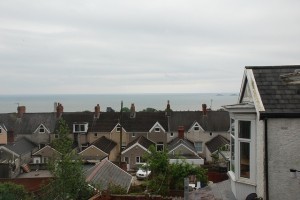 In Dylan’s little room, illuminated by an antique gas lamp, a collectable copy of “A Child’s Christmas in Wales” sits on a small table. Lines from that book are painted on the walls. Annie asks if I notice anything. I read the lines and ask if one might have a mistake. She brightens and says there’s not just one mistake but several “because there’s nothing more empowering for a child than to say to an adult, ‘you’ve got it wrong.’ ”
In Dylan’s little room, illuminated by an antique gas lamp, a collectable copy of “A Child’s Christmas in Wales” sits on a small table. Lines from that book are painted on the walls. Annie asks if I notice anything. I read the lines and ask if one might have a mistake. She brightens and says there’s not just one mistake but several “because there’s nothing more empowering for a child than to say to an adult, ‘you’ve got it wrong.’ ”
She looks me up and down and asks, “How tall are you?” I tell her 5-5. “Well then, you’re a half inch taller than Dylan.” I concede I’m really 5-4-and-a-half. She seems pleased that I’m the same height as her beloved bard.
“I know Dylan,” she says. “I’m his mother now.” Then Dylan’s mother retreats to the kitchen to bring out lamb “that’s come nine miles to be with us tonight,” fresh pastry-crusted salmon from the nearby River Tawe, potatoes and a divine bottle of French Cotes du Rhone. Later she’ll top off the feast with a fresh-baked rhubarb-fruit tart.
I suggest the house is a labor of love, but Annie is quick to correct me. “It’s a labor born of frustration,” she says. “This boy of ours hasn’t been acknowledged and he should be.”
Annie says I can choose where I’ll sleep and invites me to stay in Dylan’s tiny boyhood room. But the room is barely bigger than the single bed so I opt for the guest room at the front of the house, which young Dylan called the “best room.”
Overlooking Cwmdonkin Park, where Dylan’s legs and imagination ran free, the spacious best room has a fireplace and brass candlesticks, a sink with a pitcher for wash water, a photo of Dylan and his wife, and a little crib. A book of Thomas’ poems waits on the nightstand.
* * *
Do not go gentle into that good night,
Old age should burn and rave at close of day;
Rage, rage against the dying of the light. …
And you, my father, there on the sad height,
Curse, bless, me now with your fierce tears, I pray.
Do not go gentle into that good night.
Rage, rage against the dying of the light.
His parents’ first language was Welsh, but Dylan was raised speaking English so he would not sound working class, Annie says. Dylan took elocution lessons to get rid of his Welsh accent and read poems in the bathroom to train his voice because he realized it’s “not just what you say but how you say it.
Many of Wales’ early and modern poets write in a strict-meter form of Welsh, but Thomas became internationally known because he wrote so eloquently in English. Yet it was Thomas’ undeniable, intrinsic Welshness that gave his poetry so much strength, Annie says. “The meter and structure is old Welsh in form and the English loved it.”
Annie tells me that Thomas wrote hundreds of poems in this house, with his greatest output coming between the ages of 16 and 20. He worked in the morning and drank late, Annie says. Unfortunately Thomas couldn’t hold his alcohol, perhaps because he’s now believed to have been a diabetic, so he became a “performing monkey,” she says.
“Obnoxious behavior became his calling card. In London he was a performer. That’s not creative, and it’s tiring. He had to keep coming back and recharging here – not just this house, this town,” she says. “He’d say when he was on the train to London (that) he wasn’t going to England, he was leaving Wales. He was leaving his heart, he was leaving his safety.”
Like a protective mother, Annie denies that Thomas was an alcoholic. There’s “such a lot of work of such high quality that alcoholism is not considered.” I refrain from listing all the great writers who overindulged in alcohol. Annie refills my glass with Cotes du Rhone and I ask about Thomas’ most famous poem, “Do not go gentle into that good night” written as Dylan’s father, a frustrated poet, lay dying.
“Listen to it from a child’s point of view,” Annie says. “His father wouldn’t give Dylan the words he needed like ‘well done’ or ‘I’m proud of you.’ The work between father and son wasn’t finished.”
Keri Finlayson, a poet and frequent visitor to No. 5 Cwmdonkin Drive, tells me that young Dylan sat upstairs and listened to the sounds of voices floating up through the vents of his two-story home. “I like thought of words flowing around static objects,” she says. “I think of the boy in this tiny room, or in the bath learning to project” his voice.
Annie tidies up the kitchen, shows me how to turn up the heat, then bids me goodnight. I’m alone in the room where Dylan Thomas was born, his words on the nightstand for company.
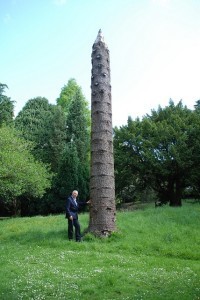 The next morning I stroll along the lush byways of Cwmdonkin Park, where a dead tree standing more than 30 feet high has been carved into the shape of a pencil to honor the bard who grew up across the street.
The next morning I stroll along the lush byways of Cwmdonkin Park, where a dead tree standing more than 30 feet high has been carved into the shape of a pencil to honor the bard who grew up across the street.
At Swansea’s Dylan Thomas Centre, a stone’s throw from the Bristol Channel, are photos of long lists of words Thomas compiled as he wrote. He placed scrolls of rhyming words before himself like an artist’s palette, selecting just the right shade for the meaning he wished to convey.
Audio recordings play in corners of the center. As I listen I understand that, similar to James Joyce, the best way to comprehend Thomas is to hear his work read aloud, ideally in his own voice.
Thomas’ work has been called “thrillingly incomprehensible” but I can hear what the Welsh call hiraeth, an ineffable longing, and it all starts to make sense. Read aloud, Thomas’ poetry becomes music. Which makes me think that Bob Dylan, who took his name from the Welsh bard, is his natural heir: a musician who turns songs into poetry.
Now that most of Swansea’s industries have declined, the city no longer harbors the smokestack stench of Dylan’s time, but still I’m eager to explore the places to which he escaped as a teen. He called his bohemian group of friends the Kardomah Gang – they took their name from the café where they gathered.
In summer, the ruffians would camp out for a week or two by Rhossili Bay, drinking in the fresh air, clear night sky and copious amounts of ale and whiskey. Today the place attracts ice-cream-cone-toting families who hike among the bleating sheep on the lush green bluffs, gazing out at the broad crescent of sand and a pair of islands called Worm’s Head, accessible by a land bridge for less than an hour at low tide.
* * *
“When I think of that concentrated muttering and mumbling and intoning, the realms of discarded lists of rhyming words, the innumerable repetitions and revisions and how at the end of an intensive five hour stretch (from 2-7) prompt as clockwork, Dylan would come out very pleased with himself saying he had done a good days work, and present me proudly with one or two or three perhaps fiercely belaboured lines.” –Caitlin Thomas, Dylan’s wife
When Thomas was 23 he left the sanctuary of his family’s Swansea home and moved to another seaside abode, a place he called the Boathouse in Laugharne (pronounced Lahrn) overlooking Wales’ west coast. Walking up a stone path on a drizzly morning, I first arrive at his “word-splashed hut” perched like a bird’s nest on a cliff above the sea.
The converted shed where Thomas created some of his best work was exposed to Wales’ tempestuous storms and crashing ocean sounds. The room remains a churning sea of manuscripts, discarded drafts of verse, empty cigarette packs and literary journals.
Farther up the stone path is the house where Dylan, his wife Caitlin and their children lived. It feels like a small ship, with low doorways (five and half feet high, just enough for Thomas). The house been converted into a homey museum, called The Dylan Thomas Boathouse at Laugharne. In the parlor is a grand radio from the 1930s. While Thomas was traveling – to London, New York or Paris – his children would gather round the radio and listen to their father recite his poetry and stories on the BBC.
At the front desk I meet Maggie Richards, who grew up in Laugharne in the 1950s. She tells me Thomas’ play for voice, “Under Milk Wood,” which has been called “Ulysses in 24 hours,” was based mostly on Laugharne. Thomas changed the name to Llareggub, which spelled backwards is Buggerall. The first performance of the play in Laugharne was in 1958, she says.
“That’s how I got interested as a small child – I used to go and see these,” Richards says. After a time the community stopped performing the play, but the Laugharne Players re-grouped in 2006. “We’re doing it again this August,” says Richards, who directed the play in 2009, “but if half the players can’t be there, it might be a one-woman show.”
The scent of baking draws me to the basement kitchen where two young women are making bara brith, a lightly sweet Welsh bread. I ask about it and they cut me a slice to taste, on the house. Walking back down the rain-slickened path, I head to Brown’s Hotel which housed one of Thomas’ favorite pubs. He spent so much time there he gave the pub’s phone as his contact number, but the hotel was closed for renovations.
Nearby is Corran’s Books in a weathered stone building with a bright blue door. Owner George Tremlett, author of a biography of Caitlin Thomas, says Laugharne is where Dylan Thomas matured as a writer.
 “His early work wasn’t very good” Tremlett says. “It was here that he found whatever it was he needed to make the mix.” What made this town so right for Thomas? It’s an egalitarian town, Tremlett says. “The rich man counts for very little here. And it’s very easy going – I think that fitted him like a glove.”
“His early work wasn’t very good” Tremlett says. “It was here that he found whatever it was he needed to make the mix.” What made this town so right for Thomas? It’s an egalitarian town, Tremlett says. “The rich man counts for very little here. And it’s very easy going – I think that fitted him like a glove.”
In his last years Thomas and his family moved to New Quay, a seaside resort that has created the Dylan Thomas Trail, a set of sights related to the poet. Number 8 is May’s Designs where the owner, a young ebullient woman named May Hopkins, has painted Thomas quotations on the walls. “When one burns one’s bridges,” reads a Thomas line, “what a nice fire it makes.” Another says: “He who seeks rest finds boredom, he who seeks work finds rest.” Says Hopkins: “That’s up for the girls who work here so they can take the hint.”
The shop sells driftwood, paintings, and photos of Dylan and Caitlin. Hopkins is proud that Thomas lived in her town. “I do like his work,” she says, “but I don’t understand a lot of it.”
I walk along a concrete pier and look out to the “fishing-boat-bobbing sea” that inspired Thomas in his last years. A lone bottlenose dolphin gracefully arcs above the water, a seal clasps a silver fish that flaps in vain.
* * *
“It is the measure of my individual struggle from darkness toward some measure of light.” –Dylan Thomas’ “Poetic Manifesto”
Before leaving Wales I attend a lunch with Thomas’ granddaughter, Hannah Ellis, who says that Dylan “clearly had a very happy childhood.” However his world was shattered in February 1941 after the German blitz leveled much of Swansea, leaving 230 dead and 7,000 people homeless in mid-winter. “Our Swansea is dead,” he writes in “Return Journey,” a BBC radio play. The play isn’t simply an elegy for his hometown, Ellis said, it’s his attempt to rebuild Swansea with his words.
Like Annie Haden, Ellis believes her grandfather hasn’t received the recognition he deserves. She hopes the upcoming centennial celebrations will change that and introduce a new generation to his work. “When I tell someone I’m Dylan Thomas’ granddaughter,” Ellis says, “I don’t want them to say ‘Who?’ ”
After almost a week in Dylan Thomas’ Wales, I have a much better sense of the poet, but there’s one last place I feel compelled to visit: the stately National Library of Wales in Aberystwyth, where some of Thomas’ possessions remain. I sit with a curator, with the delightfully Welsh name of Ifor Apdafydd, in a high-ceilinged room. Apdafydd shows me a map of downtown Swansea that Thomas drew, a betting slip with odds on horses, a Pan American airline ticket, and a letter to his uncle thanking him for a gift and praising the Disney movie Dumbo.
The curator then unwraps a leather wallet containing Thomas’ passport. “Can I hold it?” I ask. Apdafydd hesitates, then consents. I slowly turn the yellowed pages and see stamps for France, Italy, and Iran, where Thomas traveled in 1951 to write a script for the Anglo Iranian Oil Company.
 Then there’s the final stamp: a New York entry into the U.S. in 1953, where, five days after allegedly boasting he’d knocked back “eighteen whiskeys, a record,” Thomas died at St. Vincent’s Hospital.
Then there’s the final stamp: a New York entry into the U.S. in 1953, where, five days after allegedly boasting he’d knocked back “eighteen whiskeys, a record,” Thomas died at St. Vincent’s Hospital.
After that last stamp, the better part of the passport is blank, no mark of a return to Britain. I survey the grand room in this house of words that Thomas helped build. “So many empty pages,” I say in a low voice as a wave of sadness washes over me. “So many pages left unfilled.”
——————————–
Shortly after this story appeared in the Washington Post in August, 2013, I received this letter:
Dear Mr. Shapiro,
I enjoyed reading your article in today’s Washington Post and I have a bit of relevant information to add to it. If you still have access to his passport I’m pretty sure you’ll find my signature at the bottom of his U.S visa and there is a little story connected with it.
At the time I was a new vice consul at the American Embassy in London. I happened to be passing through the reception area of the visa section when I encountered a noisy confrontation between one of the reception clerks and a man who looked like an impoversihed hobo. The clerk was demanding that the visitor go away and I overheard their conversation. When I understood that the shabby visitor was actually Dylan Thomas, I immediately invited him to my office and issued him an American visitor’s visa. Unfortunately, his visit to America ended in tragedy but I retained an abiding interest in his poetry.
Edward
August 23, 2013
Vin Scully suspended for PEDs
 LOS ANGELES — Veteran Los Angeles Dodgers broadcaster Vin Scully was suspended today by Major League Baseball for 50 games after performance enhancing drugs were found in the announcer’s booth at Dodger Stadium.
LOS ANGELES — Veteran Los Angeles Dodgers broadcaster Vin Scully was suspended today by Major League Baseball for 50 games after performance enhancing drugs were found in the announcer’s booth at Dodger Stadium.
A random search found No Doz and Sudafed in Scully’s section of the booth, which contain substances banned by MLB.
“Honestly, Scully is the last person we’d like to see suspended,” said MLB Commissioner Bud Selig, “but in accordance with last year’s expansion of baseball’s PED policy to include all team employees, we had no choice.”
Scully, 85, will miss the remainder of the regular season and the National League playoff series. If the Dodgers make it to the World Series, he’ll be eligible to return for some of those games.
The voice of the Dodgers, beloved by fans, had just announced he’d be returning for a record-setting 65th season next year.
“I’m shocked and saddened by this,” he said. “I had no idea I was violating the rules of the sport I love, but I accept full responsibility.”
Scully vowed he’ll never use PEDs again but said he may have to re-work his contract for next season to give him the fourth through sixth innings off, so he can take a nap.
The Dodgers have hired former pitcher Steve Howe to fill in for Scully during the suspension.
- Michael Shapiro contributed to this story
May 29, 2013
Barbara Kingsolver interview, Press Democrat
Author Barbara Kingsolver’s most recent book is “Flight Behavior.”
I love interviewing authors because they have so much to say. I learned that the easy way when I put together my first literary book, “A Sense of Place” — a collection of conversations with travel writers. Last fall I spoke with a hero of mine, Barbara Kingsolver, and hoped to ask her something that would go beyond the thousands of interviews she’s already done. So I asked her:
Q. You seem to try something new in each of your books. What was your greatest challenge in this one?
And she replied that she’d never been asked that and enthusiastically responded:
A. It’s really important to me not to write the same book twice, not even close. What gets me to my desk every day is the thrill of doing something new, that I’m not at all sure I can really pull off. In (“Flight Behavior”), the scary, difficult thing … was to write about climate change, to write about science and convey the basic fundamentals in an artistic way. As a person trained in science, I feel this is mission work: To carry important ideas of science that people really need to know. … In the beginning I had no idea how I was going to succeed at that, and at the end I felt, by golly, that I did.
For the full story, click here.
May 17, 2013
The Bird Men of Mazatlan: Cliff divers wait for tide to come in, Mariner
In the fall of 2009, Mariner magazine asked if I’d go to Mazatlan to write about the cliff divers there. I’d watched cliff divers in Acapulco during the ’70s on ABC’s Wide World of Sports but didn’t know they were still plunging into the sea. I spent three days with the divers, who – if they don’t time their dives right – may crash into way-too-shallow water. Occasionally there are fatalities. I had two days between the Mazatlan trip and a 24-day journey down the Grand Canyon and wrote this piece at the sleek Hotel Valley Ho in Scottsdale. You can read it by clicking here for the virtual magazine. Use the arrows at the top left to turn the pages.
Michael Shapiro's Blog
- Michael Shapiro's profile
- 3 followers


